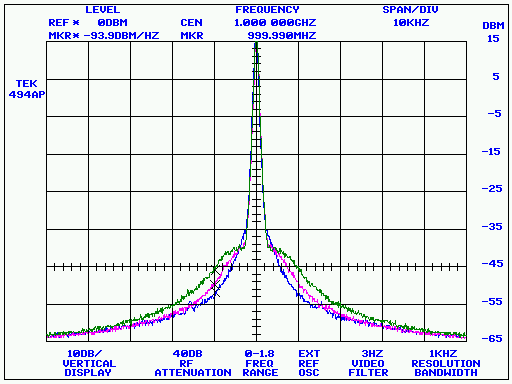
Welcome to the GPIB Toolkit!
The GPIB Toolkit is a collection of free Windows utilities that will help you make and record research-quality measurements with GPIB-based electronic test equipment.
This is version 1.994 of the Toolkit, released April 27, 2025.
Download the GPIB Toolkit (4 MB)
For troubleshooting help and additional application notes, check the FAQ.
The GPIB Toolkit is provided with full C++ source code for public- and private-sector, educational and Amateur Radio / hobbyist use. Comments and feedback are always welcome.
John Miles, KE5FX
john@miles.io
Note: As of July 2016, some false positives have been reported from certain virus scanners including Microsoft Security Essentials/Windows Defender. As long as the confirmation dialog includes a valid signature for Miles Design LLC, the file's
code signature is intact, and you can safely disregard these warnings. This issue appears to have been resolved in the 1.225.1983.0 antivirus definition update.
7470
7470.EXE is a Win32-based emulator for the HP 7470A plotter. See its User Guide for more information.
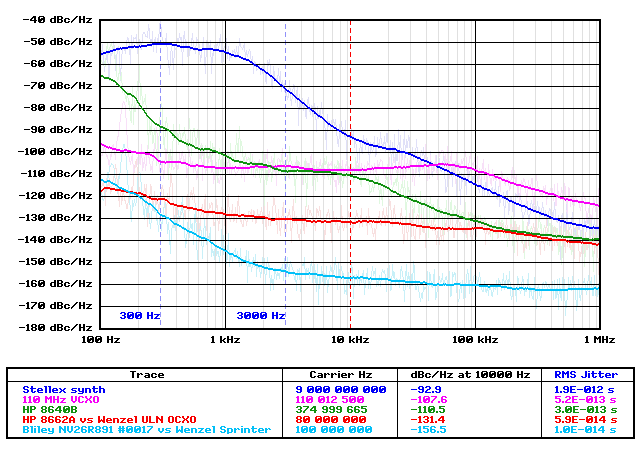
PN
PN.EXE is an automated phase-noise measurement utility for HP, Tektronix, and Advantest spectrum analyzers.
See its User Guide for more information.
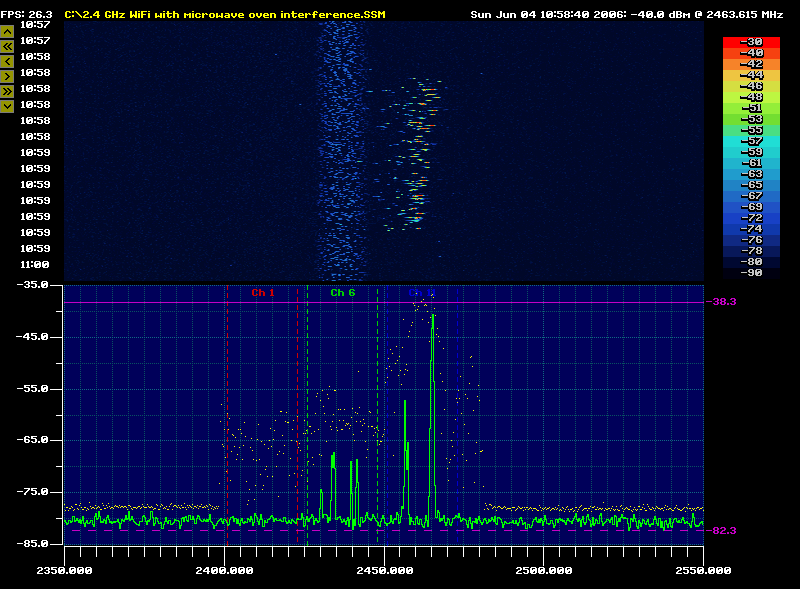
SSM
SSM.EXE is a spectrum surveillance monitor application for HP, Tektronix, and Advantest spectrum analyzers, as well as Signal Hound USB spectrum analyzers. See
its User Guide for more information.
GPIB CONFIGURATOR
PROLOGIX.EXE allows you to select and configure a Prologix GPIB-USB or GPIB-ETHERNET adapter for use with the GPIB Toolkit applications. It can also be used to select
a National Instruments adapter, or to configure the GPIB Toolkit to work with an otherwise-unsupported TCP/IP or serial adapter.
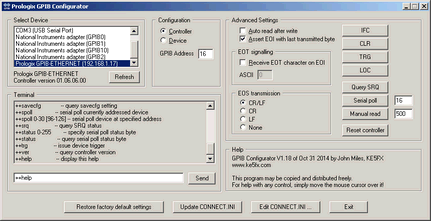 Most of the GPIB Toolkit applications support both Prologix and National Instruments GPIB adapters. By default, the Toolkit expects to find a National Instruments device
at GPIB0. When using a Prologix adapter, it's necessary to edit the CONNECT.INI file to tell the GPIB Toolkit where to find the Prologix adapter's
virtual serial port or network address.
Most of the GPIB Toolkit applications support both Prologix and National Instruments GPIB adapters. By default, the Toolkit expects to find a National Instruments device
at GPIB0. When using a Prologix adapter, it's necessary to edit the CONNECT.INI file to tell the GPIB Toolkit where to find the Prologix adapter's
virtual serial port or network address.
This task is easy to accomplish with PROLOGIX.EXE. Simply run the program, select the Prologix or National Instruments adapter in the device list, and press the
Update CONNECT.INI button. (Be sure to exit from PROLOGIX.EXE before attempting to run any other GPIB Toolkit application.)
You can use the Edit CONNECT.INI button in PROLOGIX.EXE as a convenient way to modify your existing GPIB configuration manually, regardless of whether
or not you're using a Prologix adapter. Editing the file also gives you access to additional options for troubleshooting and optimization. See the
comments in CONNECT.INI for more information.
Beginning with the V1.50 release of the GPIB Toolkit, it is no longer necessary to select Device or Controller mode in PROLOGIX.EXE unless you wish to use the optional Terminal
or Advanced Settings controls. Each Toolkit application will configure the Prologix adapter's
mode and address settings as needed.
Usage examples:
prologix Run with no command-line options for normal enumeration of all
Prologix GPIB-USB, GPIB-ETHERNET, and National Instruments adapters
prologix -noni Don't attempt to enumerate National Instruments adapters (useful if
error messages are reported after a partial NI488.2 driver uninstallation)
prologix -nonet Don't issue UDP broadcasts to detect Prologix GPIB-ETHERNET adapters
VNA
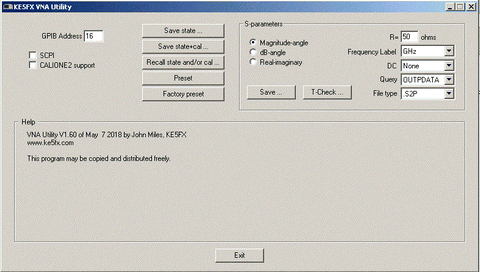
VNA.EXE allows you to save and load control/calibration states for HP 8753, HP 8510, and HP 8720-series vector network analyzers. Touchstone .S2P files can also be acquired from these models, as well as from the FieldFox portables. VNA.EXE can eliminate the need for a disk drive
in many cases.
Release 1.00 of 5-Feb-13
- Fixed some compatibility issues with Prologix GPIB-USB and GPIB-ETHERNET adapters
Release 1.10 of 23-May-13
- Added "Save .S2P file" button
Release 1.20 of 15-Jun-13
- .S2P export functionality verified compatible with HP 8510B. Renamed 8753.EXE to VNA.EXE to reflect support for multiple instruments
Release 1.30 of 28-Aug-13
- Added the ability to export .S2P data in dB/angle or real/imaginary format as well as the default magnitude/angle format
- Added the ability to specify the reference resistance for saved .S2P files
Release 1.40 of 28-Sep-14
- Added progress indicator for lengthy operations
- On 8753-series VNAs, the .S2P export function now restores the previously-active parameter when finished. Previous versions left S22 active.
- Improved reliability of .S2P export function when using Prologix adapters
Release 1.50 of 30-Sep-14
- Support for saving/recalling instrument states and calibration data on HP 8510 series VNAs (tested on HP 8510C)
- Added Factory preset button
- More reliability improvements for Prologix adapters
Release 1.51 of 5-Oct-14
- .S2P export function now supports all sweep types on 8753- and 8720-series VNAs, including log and list sweeps. Only linear sweeps are supported on 8510 models.
- Factory preset button now supports HP 8510A/B analyzers
Release 1.52 of 23-Dec-14
- Fixed bug introduced in V1.51 that caused .S2P frequency values in linear sweeps to begin at 0 Hz rather than the start frequency
Release 1.53 of 15-Jan-15
- Added support for Hz, kHz, and MHz frequency values in .S2P files
Release 1.54 of 13-Jul-15
- Added T-Check function to characterize calibration uncertainty
- Added .S2P support for Agilent/Keysight FieldFox portable VNAs (tested with N9923A)
- Added optional support for initial DC entry in .S2P files
Release 1.55 of 14-Jul-15
- Additional functionality (spline interpolation, multiple .S2P file display, etc.) added to T-Check viewer
Release 1.56 of 25-Apr-16
- CALIONE2 (one path two-port) calibration type supported for 8753 series
Release 1.57 of 29-Oct-16
- Added check box in order to avoid lockups on instruments that don't support CALIONE2, such as HP 8719C
- .S2P support added for 8722 series
Release 1.58 of 28-Sep-17
- Added "Save .S1P file" button
Release 1.60 of 7-May-17
- New options added to select OUTPFORM data and save S22 data to .S1P files
Release 1.61 of 30-Jul-18
Release 1.62 of 2-Oct-18
- Added option to save S21 data to .S1P files
Release 1.63 of 26-Mar-20
- Fixed issue that caused the T-Check viewer to fail to render certain .S2P files
Release 1.64 of 18-Jan-21
- When saving a Touchstone file, the magnitude of S11 and S22 at DC is now set to 0.0 instead of 1.0 when "Unity mag" is selected
Release 1.65 of 22-Feb-21
- Added 'Initiate single sweep' checkbox option. This box is checked by default to maintain the previous behavior, but may be unchecked when necessary to save S parameters without triggering a new sweep.
SATRACE
SATRACE.EXE can be thought of as a console-oriented version of SSM. It requests one or more traces from any spectrum analyzer supported by SSM,
and writes them to stdout as lists of comma-separated frequency/amplitude pairs.
SATRACE's command-line parameters are very similar to those supported by SSM.
Usage: satrace <address> [<options>...]
Examples using GPIB address 18:
satrace 18 Auto-identify analyzer at GPIB address 18 and acquire
a single trace from it
satrace -sa44 Special option required for use with USB-SA44/B or
USB-SA124A Signal Hound (No GPIB address is needed)
satrace 18 -856xa Special option required for use with HP8566A-HP8568A
satrace 18 -8569b Special option required for use with HP8569B/8570A
satrace 18 -358xa Special option required for use with HP3588A/3589A
satrace 18 -3585 Special option required for use with HP3585A/B
satrace 18 -advantest Special option required for use with supported
Advantest R3200/R3400-series analyzers
satrace 18 -r3261 Special option required for use with R3261/R3361
satrace 18 -scpi Special option required for use with Agilent E4400-
series and other SCPI-compatible analyzers
satrace 18 -f Favor speed over resolution, CRT updates, or other
factors (if supported)
satrace 18 -t Disable GPIB timeout checking during long sweeps
satrace 18 -ao:-7 Add -7 dBm to all reported amplitude values
satrace 18 -fo:150000000 Add 150 MHz to all reported frequency values
satrace 18 -reps:15 Acquire 15 successive traces (0 = run until keypress)
satrace 18 -trace:"TA" Acquire from specified trace (HP 8568B/8566B only,
" default="TA")
satrace 18 -header Display time/datestamp and available analyzer control
settings
satrace 18 -lf Separate frequency/amplitude pairs with linefeeds
rather than commas
satrace 18 -spline:800 Resample trace using cubic spline reconstruction to
generate (e.g.) 800 points, regardless of the
analyzer's trace array width
satrace 18 -point:128 Resample trace using point-sampled values
satrace 18 -min:128 Resample trace using minimum bucket values when more
source points than requested are available
(otherwise use spline)
satrace 18 -max:128 Resample trace using maximum bucket values when more
source points than requested are available
(otherwise use spline)
satrace 18 -avg:128 Resample trace using averaged bucket values when more
source points than requested are available
(otherwise use spline)
satrace 18 -connect:"xxx"
Specify GPIB command string to be issued when
initially connecting to instrument
satrace 18 -disconnect:"xxx"
Specify GPIB command string to be issued when
disconnecting prior to program termination
satrace 18 -856xa -f Example using multiple options
Like SSM, SATRACE does not normally attempt to control or configure the spectrum analyzer. Traces are acquired based on the current
front-panel settings such as center frequency, reference level, resolution bandwidth, and so forth. However, SATRACE does provide
limited control options for certain analyzer models. These options are shown below.
Additional control options supported by Signal Hound only:
-RL:-40 Specify reference level in dBm (default = -30)
-CF:90.3E6 Specify center frequency in Hz (default = 900 MHz)
-span:10E6 Specify span in Hz (default = 1 MHz)
-start:88E6 Specify sweep start frequency (default = 899 MHz)
-stop:108E6 Specify sweep stop frequency (default = 901 MHz)
-bins:64 Specify FFT kernel size (power of 2 from 16 to 256,
default = 128)
-sens:2 Specify sensitivity factor (default = 2, range 0-2)
-RFATT:10 Specify RF attenuation in dB (0-15 dB in 5-dB steps,
default = 0)
In most cases, SATRACE's output will be "piped" to another file or application. For example, the command
c:\program files\ke5fx\gpib>satrace 18 -reps:100 -point:500 >temp.txt
will read 100 successive traces from the analyzer at GPIB address 18, point-sample them to generate
500 (Hz,dBm) value pairs for each trace, and write the resulting comma-separated value lists to the file temp.txt.
For more details on trace resampling, see the FAQ ("How do the trace-resampling options in SATRACE and SSM work?").
Release 1.01 of 25-Jul-08
- Tektronix 49x/275x analyzers now use low-resolution mode by default to avoid checksum errors
Release 1.02 of 08-Sep-08
- Added support for MAX SPAN traces from Tektronix 49x/275x and 271x analyzers
Release 1.03 of 20-Oct-08
- Added support for the Advantest R3132 family of spectrum analyzers, including the R3132, R3162, R3172, and R3182 models
- Fixed bug that could cause assertion failures on Agilent E4400-series instruments
Release 1.04 of 08-Apr-09
- Added support for the Advantest R3261/R3361/R3265/R3271-family of spectrum analyzers
Release 1.05 of 30-May-11
- Added support for the Agilent E4406A vector signal analyzer
Release 1.06 of 31-Jul-12
- Added support for Anritsu MS2650/MS2660 series (via -scpi option)
- Added support for the USB-SA44/B and USB-SA124A Signal Hound spectrum analyzers
Release 1.07 of 28-Aug-13
- Added SCPI support for Agilent N991x- and N993x-series FieldFox RF analyzers in spectrum analyzer mode. For more information on direct connectivity to Ethernet devices, search the FAQ for FieldFox.
Release 1.08 of 28-Jul-15
- Fixed a byte-order issue that could cause invalid data to be acquired from a FieldFox analyzer
Release 1.09 of 4-Aug-16
- Added support for Advantest R3131 (via -advantest option)
Release 1.10 of 29-Jul-21
- Added -trace command line option for HP 8566B/8568B analyzers
- Fixed bug that caused -connect and -disconnect options to fail with GPIB commands containing spaces
Release 1.11 of 24-Nov-22
- Fixed bug that caused incompatibility with R&S FSU in SCPI mode
Release 1.12 of 27-Apr-25
- Added support for HP 89410A and 8944xA vector signal analyzers
SGENTEST
SGENTEST.EXE tests HP signal generators (8656A/B, 8757A-D, 8642B/M,
8662A/8663A, 8672A and others) by programming randomly-chosen frequency
and amplitude settings. Output signals are then verified by an
HP 8566A/B, 8568A/B, or 8560A/E-series spectrum analyzer.
Usage: sgentest <analyzer address> <generator address> [<options> ...]
Available options (with default or example values):
-fmax:1.2E9 .... Maximum test frequency = 1200 MHz
-fmin:10E3 .... Minimum test frequency = 10 kHz
-amin:-90 .... Minimum test power = -90 dBm
-amax:10 .... Maximum test power = 10 dBm
-loss:1.0 .... Interconnect loss in dB at fmax
-ftol:200 .... Frequency tolerance = +/- 200 Hz
-atol:2 .... Amplitude tolerance = +/- 2 dBm
-wait:0.25 .... Wait 250 milliseconds after programming generator
-8662 .... Check for HP 8662A/8663A hardware errors
-8672 .... Compatibility mode for HP 8672A signal generators
-8560 .... Compatibility mode for certain HP 8560A/B/E portable analyzers
-log:filename .... Log output to filename
-trials:1000 .... Stop after 1000 trials
-verbose .... Display/log all trials, not just failures
-srand:500 .... Seed random # generator with integer
-stime .... Seed random # generator with time() function
Notes:
- Minimum test power must be sufficient to yield good amplitude measurements
- Numeric arguments are reals, and may use scientific notation
- 8662A/8663A hardware error checks are disabled by default
- Some 8560A/B/E-series portables may require -8560 switch for compatibility
(which inhibits use of KSX and KSb commands for amplitude correction and
positive-peak detection)
- Test will run indefinitely if -trials is 0 (or not specified)
- Default -loss value is based on 15 feet of LMR-400 and two N connectors at fmax=1.2E9
- When using the -8672 option, set the front panel RANGE control to minimum power (-110 dBm) to avoid false readings
Example to test HP 8663A at address 19 with analyzer at address 18, using 15 feet of LMR-400 cable (1.0 dB loss) with N connectors (0.15 dB each):
sgentest 18 19 -fmax:2559E6 -amax:19 -8662 -loss:1.3
Example to test HP 8672A at address 19:
sgentest 18 19 -8672 -fmax:18E9 -fmin:2E9 -amax:8 -amin:-50 -atol:4 -loss:4
Miscellaneous Win32 Console Applications
By default, the following utilities are installed with the rest of the GPIB Toolkit executables in the installation directory, normally C:\Program Files\KE5FX\GPIB or C:\Program Files (x86)\KE5FX\GPIB. In most cases you can obtain usage notes by running
each program with no command-line arguments.
PARSE.EXE is a simple command-line utility that allows you to inspect HP-GL files by dumping their instructions to stdout.
QUERY.EXE is a standalone GPIB query utility intended for diagnostic purposes and batch/shortcut files.
TALK.EXE is a standalone GPIB command-transmission utility intended for diagnostic purposes and batch/shortcut files.
LISTEN.EXE is a standalone GPIB data-reception utility for ASCII traffic, intended for diagnostic purposes and batch/shortcut files.
BINQUERY.EXE is a standalone GPIB query utility intended for diagnostic purposes and batch/shortcut files. It illustrates
how to retrieve arbitrarily-large binary data blocks from GPIB instrumentation.
PSAPLOT.EXE retrieves .GIF screenshots from an Agilent PSA-series spectrum analyzer (tested on E4443A with firmware version A.11.21). It also works with the E4406A vector signal analyzer and possibly with other E4XXX-series models.
GPS.EXE is an example program for the GNSS.DLL library. It displays incoming latitude, longitude, and altitude fixes. GNSS.DLL provides a C API for NMEA-compatible GPS receivers such as the u-blox LEA-6 series.
5071A.EXE sets the clock on an HP 5071A / Symmetricom 5071A primary frequency standard from a specified NTP server.
5345A.EXE and 5370.EXE are two example programs that show how to communicate via GPIB with the HP 5345A and HP 5370A/B frequency counters, respectively. They are
meant to be modified and recompiled as needed.
8672A.EXE programs the output frequency and (optionally) power level for the HP 8672A microwave signal generator.
DTS2070.EXE demonstrates capture of timing data from a Wavecrest DTS2070 timing analyzer. Like the HP counter
utilities it is meant to be modified as needed.
ATTEN_3488A.EXE demonstrates remote control of RF step attenuators via a HP 3488A / HP 44170A programmable switch
44471A.EXE supports relay control on HP 3488A / HP 44471A
T962.EXE reads data from a Puhui T962-series oven with ESTechnical firmware. (experimental)
TXCOM.EXE transmits an arbitrary string to a COM port, without resetting devices such as Arduinos by asserting DTR
MTIE.EXE computes ADEV and MTIE statistics for phase data
DSO6000.EXE retrieves voltage data from a trace captured on an Agilent DSO/MSO6000A-series oscilloscope. If an output filename is supplied on
the command line, the data will be written as a series of double-precision binary values; otherwise, the voltage values will be printed to stdout.
DSO6000.EXE assumes that a SINGLE sweep has run to completion, and that the oscilloscope is in STOP mode (STOP/RUN button illuminated red.)
It was tested on an MSO6054A, and may or may not be compatible with other Agilent models such as the DSO/MSO5000A series.
CAL_TEK490.EXE contains various calibration aids from the Tektronix 492P service manual. Run the program for a menu of
available calibration routines.
DATAQ.EXE acquires data from a DataQ DI-154RS or DI-194 serial DAQ adapter.
SSMDUMP.EXE and SSMCHAN.EXE show how to access the row data from an .SSM file.
ECHOCLIENT.EXE and ECHOSERVER.EXE are intended for troubleshooting and benchmarking TCP/IP connections. These utilities communicate over port 4242. (Note that
benchmark results obtained from these programs are normally limited by the GPIB Toolkit's network layer, rather than by the connection itself.)
PRINTHPG.EXE sends a plotter data file (.PLT, .HPG, etc.) to the default DOS printer (PRN device). This printer should
be an HP LaserJet or compatible model that supports legacy HP-GL commands. Other printers can be used by 7470.EXE, but
the bitmaps printed by 7470.EXE will lack the resolution and fidelity obtainable by sending the plotter file directly
to a genuine HP-GL-compatible printer.
If you have a LaserJet and want the best-quality black-and-white output possible, PRINTHPG.EXE is the way to go.
Note that even LaserJets don't support some HP-GL features, like UC (User Character) opcodes! If your instrument relies on these, you'll need to use 7470.EXE to render its plots and print them as fixed-resolution bitmaps.
TCPLIST.EXE transmits a string to a specified TCP/IP address and listens for a reply. Command-line options specify the timeout interval, EOS character, and the number of ASCII text lines
expected in response. TCPLIST.EXE is handy for accessing instruments that support Telnet connections or other simple ASCII-based protocols. (Deprecated in favor of READINST.EXE, described below.)
READINST.EXE is similar to TCPLIST but offers several more command-line options. In most cases, READINST should be used in preference to TCPLIST.
READPKR.EXE fetches pressure readings from an Inficon PKR251 or compatible sensor using HP 34410A over TCP/IP
NTPQUERY.EXE requests the current time from a specified NTP server (e.g., ntpquery pool.ntp.org).
VISADMM.EXE acquires data from an HP 34461A or similar VISA-capable DMM. (Requires VISA drivers, which other apps in the GPIB Toolkit do not.)
11848A.EXE is an experimental program for direct control of an HP 11848A Phase Noise Interface from the 3048A system.
Example Batch Files for Instrument Control

By default, the following batch files are installed with the rest of the GPIB Toolkit executables in the installation directory. They may be
inspected and modified with any word processor or text editor capable of working with plaintext ASCII files.
READ_3446XA.BAT uses READINST.EXE to fetch readings from an HP 3446xA or 34470A DMM. A similar batch file (READ_34461A.BAT) uses the older TCPLIST.EXE program instead.
WIFI_HP8566.BAT uses TALK.EXE to program an HP 8566B spectrum analyzer at GPIB address 18 for 2350-2550 MHz sweeps at 5 dB/division, selecting a -35 dBm reference level and 0 dB of RF
attenuation. It then launches SSM.EXE with max-accumulation and WiFi band boundaries enabled.
WIFI_TEK490.BAT uses TALK.EXE to program a Tektronix 492P/494P/494AP/497P analyzer at GPIB address 3 in a similar fashion. The
analyzer's CRT readout is turned off to prevent burn-in.
WIFI_E4406A.BAT programs an Agilent E4406A Vector Signal Analyzer at GPIB address 18 to display the middle 10 MHz of WiFi channel 1 (2412 MHz).
It then launches SSM.EXE with max-accumulation and WiFi band boundaries enabled.
GPS_SA44.BAT programs a Signal Hound USB-SA44/B or USB-SA124A spectrum analyzer to display the middle 6 MHz of the GPS L1 band at 1575.42 MHz.
It then launches SSM.EXE with max-accumulation and GPS band boundaries enabled.
R3267.BAT uses BINQUERY.EXE to request .BMP images from an Advantest R3264, R3267, or R3273 spectrum
analyzer at GPIB address 7.
TDSBMP.BAT uses BINQUERY.EXE to request color .BMP images from a Tektronix TDS-series oscilloscope. This should work with most TDS models (tested on TDS 694C).
IMD_8566B_8568B.BAT uses TALK.EXE to transmit the downloadable program (DLP) T_HIRDIMOD to the nonvolatile user RAM on
an HP 8566B or 8568B spectrum analyzer. This program performs basic third-order intermodulation distortion
measurements on signals between 10 MHz and 500 MHz, and also calculates IP3. See HP product note 8566B/8568B-1 for more information.
Additional 8566B/8568B DLPs may be installed with WATER_8566B_8568B.BAT (waterfall display), HARM_8566B_8568B.BAT (harmonic distortion measurement),
PEAKS_8566B_8568B.BAT (peak detection/measurement) and INTRO_8566B_8568B.BAT (demo of various DLP features). MAIN_MENU_8566B_8568B.BAT shows a list of keypresses used to launch some of the above programs. Thanks to rmb_guru and Brian Flynn, GM8BJF for recovering these interesting technological artifacts.
ESM.BAT uses TALK.EXE to control a Rohde & Schwarz ESM-500A receiver. Run the batch file without any arguments to see a brief
usage guide.
TSCCMD.BAT uses TCPLIST.EXE to control a Symmetricom TSC 5115A/5120A/5125A phase noise test set. Run the batch file without any arguments to see a brief
usage guide.
TCP2PNP.BAT uses TCPLIST.EXE to save the phase noise spectrum from a Symmetricom TSC 5115A/5120A/5125A as a .PNP file
compatible with the PN.EXE phase noise utility.
SET5071A.BAT uses 5071A.EXE to set the clock on the HP 5071A at the specified COM port to the current NTP time obtained from pool.ntp.org.
Example HP-GL/2 (.PLT), Phase Noise Plot (.PNP), and Touchstone (.S2P) Files
The installation directory also contains three subdirectories, Composite noise baseline plots, Sample HPGL files, and Sample S2P files.
These subdirectories contain a variety of .PNP, .PLT, and .S2P files that can be loaded and displayed by the
PN, 7470, and TCHECK applications respectively.
User Contributions and Third-Party Software
HP 8753 S2P Downloader, contributed by Melvin Clarkson of Aspire Design Ltd, fetches Touchstone .S2P S-parameter files from an HP 8753 A/B/C network analyzer equipped with a Prologix USB adapter. VB 2010 source is included. These .S2P files may be imported into circuit simulator programs including the
free RFSim99 package. Melvin's utility may be helpful if you have difficulty using the newer VNA.EXE application described above. To use the program, unzip the file and run bin\Debug\SerialPortCommunication.exe. Select the Prologix adapter's COM port, then press the "Open Port" and "S paras" buttons.
Another VNA control application worth checking out is VNA_Qt from Benjamin Vernoux of France. Benjamin has ported some of the functionality from VNA.EXE to the Qt cross-platform framework, potentially opening up a path to Linux and MacOS compatibility. Unlike VNA.EXE, VNA_Qt is directly compatible with the HP 82357B adapter without depending on NI488.2 API support.
HP 8903B audio analyzer users may wish to check out the work done by Pete Millett here.
Lance Lascari at RFdude.com has some nice GPIB applications for RF/microwave measurements.
HP3458.EXE, contributed by Mark Sims, allows you to back up the data and/or calibration NVRAMs from the HP 3458A multimeter. Run with no command-line options for usage guidelines, and refer to the comment header in HP3458.CPP for more information.
Bertrand, VE2ZAZ has developed a handy Python application for the Agilent E4406A that can stitch multiple 10 MHz spans together to emulate a wideband sweep. SSM can do this as well (as of release 1.49), but Bertrand's app has the advantage of being compatible with any platform that supports Python.
Damien Douxchamps has another useful Python-based screenshot solution that seems to deliver excellent results with HP instruments.
Dick Benson, W1QG provides an array of useful MATLAB utilities at his MathWorks community page. Supported instruments include the 8753A-E series VNAs, 8970A/B noise figure meters, and many others.
Anders Gustafsson has modified the GPIB Configurator app to support the use of Prologix adapters (including homebrew versions, in his case) with the HP 3852A modular T&M system.
Gquipment.com offers a useful online plotter for .S1P/.S2P data, suitable for use with VNA.EXE and other utilities that work with Touchstone files.
PE1FOD has authored a useful Excel spreadsheet for Y-factor noise figure calculations with spectrum analyzers.
Released into the public domain 16-Dec-05 by John Miles, KE5FX.
Please contact john@miles.io with feedback and enhancements!
Some DSPLIB components used by the GPIB Toolkit are
subject to open-source license agreements; see the current DSPLIB distribution for details.
Source code compilable with the free Microsoft Visual Studio Express package
No warranties, expressed or implied, are offered with these programs.
Use at your own risk!
 Most of the GPIB Toolkit applications support both Prologix and National Instruments GPIB adapters. By default, the Toolkit expects to find a National Instruments device
at GPIB0. When using a Prologix adapter, it's necessary to edit the CONNECT.INI file to tell the GPIB Toolkit where to find the Prologix adapter's
virtual serial port or network address.
Most of the GPIB Toolkit applications support both Prologix and National Instruments GPIB adapters. By default, the Toolkit expects to find a National Instruments device
at GPIB0. When using a Prologix adapter, it's necessary to edit the CONNECT.INI file to tell the GPIB Toolkit where to find the Prologix adapter's
virtual serial port or network address.




